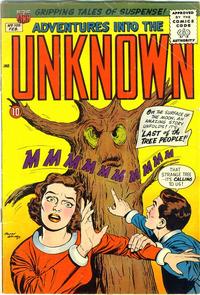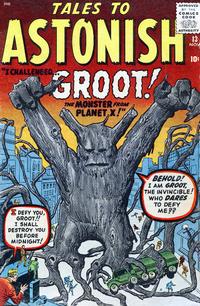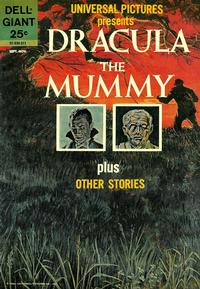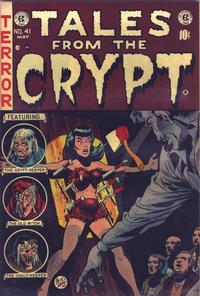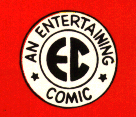
Dr. Wertham, EC Comics,
and My Misspent Youth:
In Search of the Unholy Grail
by Lawrence Watt-Evans
When I asked the editor I originally wrote this piece for what sort of article he'd like, he suggested the first half of the title above.
I think there may be some false assumptions involved here, but what the heck, let me take a shot at it.
I was born in 1954, fourth of six kids. (Well, actually, when I was born, I was fourth of four, but two more came along later.) The oldest was my sister Marian, who was born in 1947. In 1955 or so, at age seven, Marian discovered comic books. (She was born late in 1947 -- I can do simple arithmetic.)
The comic books she discovered were mostly published by two companies, Dell and National (which at the time labelled its comics "Superman-DC"). She latched onto Green Arrow, Batman, Turok, Tarzan, The Lone Ranger, Tonto, Sgt. Preston of the Yukon, and so forth.
When my brother Bill learned to read, in 1956 or so, he started reading Marian's hand-me-downs and also went in for DC's other superhero titles.
Then came Jody, who learned to read in 1956 at age five; she liked DC, especially Superboy and Wonder Woman, and Dell's Little Lulu, Uncle Scrooge, and Disney specials like Cinderella.
All comic books were treated as communal property; whoever bought one could read it first, but then it got passed around, and when everyone had read it it went up to a box in the attic. Periodically, on boring rainy days, somebody would go up to the attic and haul down a stack of old comics to re-read.
You'll notice that they all three started reading comics in very quick succession, despite age differences; it made the three of them something of a group within the family, trading those comics around, while I and my two younger sisters were shut out at first.
When I was five, late in 1959 or early in 1960, I desperately wanted to learn to read so I could read those comic books. I'd learned the alphabet in kindergarten, and one day the teacher was teaching us a song that she'd written on the blackboard, something about "K-k-katy, beautiful Katy," and the concept of each letter representing a sound abruptly dawned on me.
I suddenly realized that maybe I could read, since I knew all the letters.
When I got home I got out the comic book that most fascinated me, a coverless old one with bright purple spaceships and trees with faces and domed cities in it, and I sat down and read it, skipping words that weren't spelled phonetically.
So much for the arguments that comic books keep kids from learning to read!
That comic book, by the way, stuck in my memory, and twenty years later I tracked it down and bought an intact copy. It's Adventures into the Unknown #105, published by the American Comics Group in 1956.
Once I started, I was a voracious reader. I went through all the comic books that my sibs had accumulated by the time I was seven, as well as several assorted children's books. By the middle of second grade I'd run out of kid stuff, and while my classmates were puzzling out "See Spot run," I was reading Heinlein's The Green Hills of Earth and Bradbury's October Country (though with both books, I totally missed the point in some stories -- sex and politics and racism were complete unknowns to me).
I picked up the first issue of X-Men secondhand, for a nickel, about six months after it came out. I read the first Justice League adventures, which Marian had bought. I liked superheroes. I also liked everything else -- I plowed through Marian's Turok and Lone Ranger and Jody's Little Lulu and Superboy and all the rest of it, loving all of it. About my favorite was Strange Adventures, a science fiction title.
It took awhile before I started buying my own, though, and when I did, at first I stuck to tried and true categories.
Then one day I picked up a secondhand copy of Tales to Astonish #13 (I know the issue because I tracked it down later), and discovered monster comics.
That comic book had four or five stories in it. The cover story was about "Groot, the Thing from Planet X!," a giant walking tree. (Yes, this was the original for the very different character in "Guardians of the Galaxy". Sort of.) Then there was a creepy one about a guy obsessed with finding the abominable snowman who becomes the abominable snowman, and one about a guy who gets turned into a wooden statue, and... well, I don't remember the others for sure anymore, but this was my first exposure to scary stuff in visual form.
I had nightmares for about a week.
I loved it.
If that sounds contradictory, it isn't really. I had nightmares a lot, about all kinds of silly things. The October Country certainly gave me nightmares, but then, so did Tommy Tomorrow and the cover art on Philip K. Dick's Eye in the Sky (I didn't actually read that book until much, much later) and even a silly Supergirl story about a red monster so gigantic you only see its feet.
I started looking for other scary comics, but didn't find much. Most Marvel monster comics were just dumb, and the Charlton ghost comics, too, and the DC "mystery" comics I came across even worse. Dell did a few that I liked -- my favorite was a one-shot giant called Universal Pictures Presents Dracula, The Mummy, and Other Stories. (Catchy title, huh?) That one gave me nightmares, too.
It seemed to me at the time that there ought to be scarier comic books than that. I wondered why DC and Marvel and Charlton and ACG never had any werewolves or vampires or anything in their spooky comics. I couldn't find any, though, and eventually I gave up.
Time marched on. Marvel's monster comics turned into superhero titles, most of which I didn't like; DC's superhero titles got more serious. ACG folded. Charlton slogged on but was always lousy. Gold Key did lots of reprints, and the stuff that wasn't reprints got really weak, with bad art and sloppy writing. I gradually stopped buying and reading comics. By 1969 I wasn't paying much attention at all, though I did pick up an issue of The New Gods and thought it was interesting.
In the fall of 1971 I stumbled across someone's collection of the first few issues of Conan the Barbarian, and I decided they looked pretty neat, but I didn't do much about it.
Then in 1974 I started collecting comics because I discovered that there was money in it; I picked up Classics Comics #1 at a yard sale for $4.25, as a curiosity, and sold it to a collector for $60.00.
I started buying up practically every old comic book I came across, with no discrimination at all.
Then I realized how many were pure junk and began to narrow down to the good ones.
Then I started reading about comic books--I got hold of The Comic-Book Book and All in Color for A Dime, by Don Thompson and Dick Lupoff, and Comix, by Les Daniels.
The articles on Superman and Batman and Wonder Woman and the rest were nothing new, but two subjects came as a revelation: the history of the original Captain Marvel, and the story of E.C. Comics, Dr. Wertham, and the Comics Code Authority.
For those who don't know, E.C. was a small comic-book publisher, in business from 1943 to 1955. From 1950 through 1954 they put out comic books often considered the best ever produced, certainly the best produced before 1960, including three no-holds-barred horror titles: Tales from the Crypt, The Haunt of Fear, and The Vault of Horror. They also did some borderline horror: Crime SuspenStories, Shock SuspenStories, Weird Science, and Weird Fantasy. Even their war titles, Frontline Combat and Two-Fisted Tales, were unusually gruesome.
About two dozen other publishers (yes, there really were that many) tried to cash in on the boom in horror comics that resulted from E.C.s success with those titles, and turned out heaps and heaps of gory horror.
Then in 1954-1955, a hue and cry led by a psychiatrist named Dr. Frederic Wertham, expert on criminal violence and author of the anti-comics diatribe Seduction of the Innocent, put all the horror comics, all crime comics, all lurid comics of any sort, out of business. Combined with the collapse of the then-existing magazine distribution system, brought about by the liquidation of the gargantuan American News Company in fancy financial maneuvers, this put about three-fourths of the comic book publishers of the time out of business, including E.C. The survivors, with two exceptions (Dell and Classics Illustrated), submitted to censorship by the newly-created Comics Code Authority.
I hadn't known about any of this.
As for that other revelation, the original Captain Marvel was the star of the Fawcett line of comics, and for a time was more popular and sold more comics than any other hero. DC had sued, claiming he was an imitation of Superman, and after years of litigation finally won and drove Fawcett out of the superhero business.
Both the Big Red Cheese and pre-Code horror had been gone since before I discovered comics, and this was the first I'd heard of either of them. I'd thought the CCA seal had always been on comic-book covers, that Superman had always been the dominant superhero.
Fascinated, I found some of the DC reprints of old Captain Marvel stories that came out in the 1970s under the title Shazam!
What a disappointment! This was the stuff that those fans had raved about?
I decided to check out E.C., though, because the raves about E.C. were even more enthusiastic than the ones about Captain Marvel.
Then I looked at the prices for E.C. comics. A ratty issue of Tales from the Crypt went for ten or fifteen dollars!
No way! After the Captain Marvel incident, I decided to pass. At least those issues of Shazam! had only cost me a quarter apiece.
A side-note here: I had actually heard of Tales from the Crypt long before. When I was eight I'd read the old Mad paperbacks, reprinting the Mad comic books -- though I didn't realize that, I thought Mad had always been a magazine. One story, "Outer Sanctum," parodying radio's "Inner Sanctum," had the narrator supposedly reading the story from a dusty old copy of Tales from the Crypt #1.
I thought they'd made the title up just for that story.
Also, over the years I'd overheard collectors mention E.C. once or twice. I assumed I'd misheard and they had said DC.
Anyway, let us skip ahead to April, 1978. I was married, unemployed, living off my wife's salary in an apartment in Lexington, Kentucky. I had a fairly extensive comic-book collection and was thinking about going into business full-time as a mail-order dealer, since my writing career wasn't going anywhere.
I saw an ad in a publication called The Buyer's Guide for Comic Fandom -- someone in Florida had died, and his widow was selling off his E.C. collection, cheap. Instead of prices in the $10-and-up range, she was asking as little as $1.50 for issues of Frontline Combat, Two-Fisted Tales, and the like.
What the heck, I thought, and I splurged. I ordered half a dozen, mostly war comics, but including one issue of Tales from the Crypt at $4.00.
I got the books, and read 'em, and I was impressed, sort of -- but they sure were strange. They weren't like anything else I'd ever read. For one thing, I wasn't sure whether the stories in Tales from the Crypt #41 were meant seriously or not -- they were sort of on the edge between horror and parody.
I liked 'em, though.
I sold that book for $16.00 -- and immediately regretted it, and decided to buy some more E.C.s. Which I did.
And from then on I was hooked. I bought more, and more, and more -- until, six years and $17,000 later, I had one of the ten most complete E.C. collections on Earth.
I did until 1994, in fact -- I'd only sold one, not counting duplicates, and I auctioned that one off for the highest cash price ever paid for an E.C. comic book.
I was lucky, though. E.C. was a small company, and only lasted about ten years in the comics business (they're still around, publishing Mad). There were only about 470 issues. (I say "about" because it depends how you figure it; they did some borderline stuff, like giveaways that they packaged for Consolidated Edison.)
Putting together an E.C. collection was expensive and time-consuming, but it wasn't really hard.
But when I was finished, or at least as close as I got (there are a few giveaways I never found), where did I go from there?
I thought about it. I considered other companies -- should I collect Fiction House? Ziff-Davis? ACG?
But I wasn't really interested in any of those. I was interested in horror comics.
So I set out to collect all the horror comics ever published in the U.S. I came close before I finally gave up and sold them all for many thousands of dollars.
So what does all this have to do with Dr. Wertham and my misspent youth?
Well, the reason E.C. got out of the business, the reason horror comics gave way to wimpy "mystery" and "monster" and "ghost" comics, was that Dr. Frederic Wertham and other anti-comics crusaders had conducted a massive campaign against these horrible mind-warping funnybooks that children were reading.
This campaign had resulted in the Comics Code Authority, a body owned and operated by the comic-book publishers to censor their products and make sure that they were fit for children to read.
When I was a kid, all the comics I read were either Code-approved and certified harmless, or came from Dell or one of its offshoots -- Dell had never subscribed to the Code but had its own in-house version that was usually followed (except in a few early-sixties books like Universal Presents -- remember, I mentioned those?).
That's why I couldn't find any really scary or gruesome stuff as a kid!
It was all Dr. Wertham's fault! He'd killed the good stuff off when I was still in diapers!
(That's a gross oversimplification, really -- he was just the most visible anti-comics crusader, but as a matter of fact he wasn't all that influential. He hated all comics, and thought superhero stuff was at least as bad as horror. The Code was emphatically not his doing -- he disapproved of it. He makes a great scapegoat, though.)
And now let me appear to change subject for just a bit -- I'll tie this in in a moment, bear with me.
Who's the best-selling writer in the world? The best-selling fiction writer in all of history, excluding religious scripture?
Stephen King, of course.
So what does King write?
Horror. Often real gross-out stuff, too.
Where'd he learn this?
From the horror comics he read as a kid. He's said as much, and admits to swiping some of his most horrific images from them. In his short story "The Boogeyman," in the collection Night Shift, he talks about E.C.'s Haunt of Fear and the artwork of Graham "Ghastly" Ingels. Together with George Romero, who remembered those same hideous old comics, he produced the hit movie "Creepshow" and explicitly based it on a horror comic.
Now, what do I do for a living?
I write books.
What kind of books?
Science fiction and fantasy.
Why?
Because when I was a kid I learned to read from Adventures into the Unknown and read piles and piles of science fiction comics and books and so forth.
Why didn't I read horror comics?
Because there weren't any. If there had been, I'd have read them, even if I had to sneak them into bed and read them under the covers, the way I snuck my radio in to listen to rock 'n' roll.
See, it ties back in. It's all Dr. Wertham's fault that I wasted my childhood with that other stuff, instead of horror comics, and didn't wind up as rich and famous as Stephen King!
Talk about a misspent youth!
A quick note: Except for the comment about Groot, I have not updated the text of the original article, even though I've spotted a few infelicities. When I wrote it, Stephen King was the world's unquestioned top-selling author; I'm aware that he now has serious competition from J.K. Rowling and others, undermining my thesis.


That's it; here's your list of handy exits:
The Misenchanted Page
Front Page | Main Site | E-mail me!
